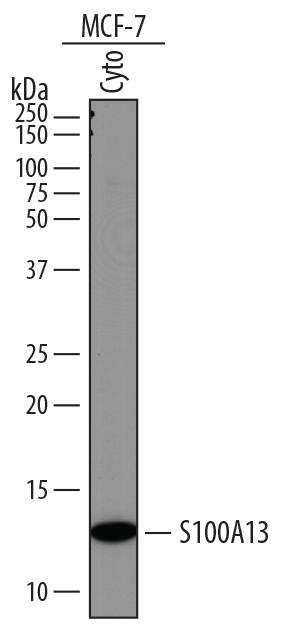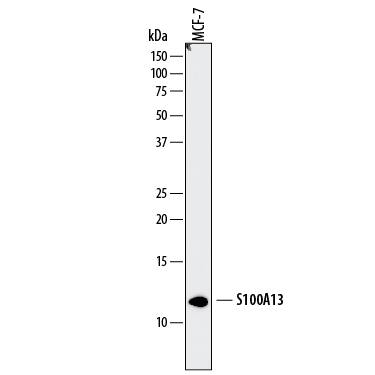S100A13 Products
S100A13 is an 11 kDa member of the S100 (soluble in 100% saturated ammonium sulfate) family of vertebrate EF-hand Ca2+-binding proteins. It is widely expressed as a homodimer with two 98 amino acid (aa) long subunits. Human S100A13 shares 83%, 90%, 91%, 87%, 78% and 47% aa identity with mouse, rat, cow, dog, opossum, and chicken S100A13, respectively. Like other S100 proteins, S100A13 is small and generally acidic, but contains a basic residue rich sequence at the C-terminus, and two EF hand motifs that bind with Ca2+ differing affinities.
Some S100 proteins, including S100A13, are able to bind the cell surface receptor for advanced glycation endproducts (RAGE). Despite lacking a signal sequence, S100A13 plays an important role in Cu2+-dependent export of FGF-1 (FGF acidic) and IL-1 alpha from the cell in response to stresses such as heat shock, anoxia and starvation. Binding of copper is necessary for formation of a multiprotein complex between S100A13, FGF-1 and p40 synaptotagmin1 (syt1). Cu2+ ions supplied by S100A13 are thought to oxidize and downregulate the activity of FGF-1 prior to export. calcium influx may also play a similar role in FGF-1 release from neuronal cells. With FGF-1 and syt1, S100A13 likely perturbs the membrane, which allows the S100A13 protein complex to exit the cell. S100A13 has been proposed as a marker for angiogenesis in tumors and endometrium, due to its role in stress induced export of FGF-1.
159 results for "S100A13" in Products
159 results for "S100A13" in Products
S100A13 Products
S100A13 is an 11 kDa member of the S100 (soluble in 100% saturated ammonium sulfate) family of vertebrate EF-hand Ca2+-binding proteins. It is widely expressed as a homodimer with two 98 amino acid (aa) long subunits. Human S100A13 shares 83%, 90%, 91%, 87%, 78% and 47% aa identity with mouse, rat, cow, dog, opossum, and chicken S100A13, respectively. Like other S100 proteins, S100A13 is small and generally acidic, but contains a basic residue rich sequence at the C-terminus, and two EF hand motifs that bind with Ca2+ differing affinities.
Some S100 proteins, including S100A13, are able to bind the cell surface receptor for advanced glycation endproducts (RAGE). Despite lacking a signal sequence, S100A13 plays an important role in Cu2+-dependent export of FGF-1 (FGF acidic) and IL-1 alpha from the cell in response to stresses such as heat shock, anoxia and starvation. Binding of copper is necessary for formation of a multiprotein complex between S100A13, FGF-1 and p40 synaptotagmin1 (syt1). Cu2+ ions supplied by S100A13 are thought to oxidize and downregulate the activity of FGF-1 prior to export. calcium influx may also play a similar role in FGF-1 release from neuronal cells. With FGF-1 and syt1, S100A13 likely perturbs the membrane, which allows the S100A13 protein complex to exit the cell. S100A13 has been proposed as a marker for angiogenesis in tumors and endometrium, due to its role in stress induced export of FGF-1.
| Reactivity: | Human |
| Details: | Mouse IgG2b Kappa Monoclonal Clone #S100A13/7483 |
| Applications: | IHC |
| Reactivity: | Human |
| Details: | Mouse IgG2b Kappa Monoclonal Clone #S100A13/7482 |
| Applications: | IHC |
| Reactivity: | Human |
| Details: | Mouse IgG2 kappa Monoclonal Clone #S100A13/7484 |
| Applications: | IHC |
| Reactivity: | Human |
| Details: | Mouse IgG2b Kappa Monoclonal Clone #S100A13/7483 |
| Applications: | IHC |
| Reactivity: | Human |
| Details: | Mouse IgG2b Kappa Monoclonal Clone #S100A13/7482 |
| Applications: | IHC |
| Reactivity: | Human |
| Details: | Mouse IgG2b Kappa Monoclonal Clone #S100A13/7483 |
| Applications: | IHC |
| Reactivity: | Human |
| Details: | Mouse IgG2b Kappa Monoclonal Clone #S100A13/7483 |
| Applications: | IHC |
| Reactivity: | Human |
| Details: | Mouse IgG2b Kappa Monoclonal Clone #S100A13/7482 |
| Applications: | IHC |
| Reactivity: | Human |
| Details: | Mouse IgG2b Kappa Monoclonal Clone #S100A13/7482 |
| Applications: | IHC |
| Reactivity: | Human |
| Details: | Mouse IgG2 kappa Monoclonal Clone #S100A13/7484 |
| Applications: | IHC |
| Reactivity: | Human |
| Details: | Goat IgG Polyclonal |
| Applications: | WB |
| Reactivity: | Human, Rat |
| Details: | Rabbit IgG Polyclonal |
| Applications: | IHC, WB, ICC/IF |
| Reactivity: | Mouse |
| Details: | Goat IgG Polyclonal |
| Applications: | WB, IHC |
| Reactivity: | Human |
| Details: | Mouse IgG1 Monoclonal Clone #854114 |
| Applications: | WB |
| Source: | E. coli |
| Accession #: | NP_005970 |
| Applications: | BA |
| Source: | E. coli |
| Accession #: | NP_033139 |
| Applications: | BA |
| Reactivity: | Mouse |
| Details: | Goat IgG Polyclonal |
| Applications: | WB |
| Reactivity: | Human |
| Details: | Mouse IgG2a Kappa Monoclonal Clone #3A7 |
| Applications: | WB, ELISA, ICC/IF |
| Applications: | WB |
| Applications: | WB |
| Applications: | WB |
| Applications: | ELISA |
| Applications: | WB |
| Applications: | WB |
Recombinant Monoclonal Antibody
| Reactivity: | Human |
| Details: | Rabbit IgG Monoclonal Clone #020 |
| Applications: | ELISA |

![Immunohistochemistry-Paraffin: S100A13 Antibody (S100A13/7483) [NBP3-26723 ] - S100A13 Antibody (S100A13/7483)](https://resources.bio-techne.com/images/products/nbp3-26723_mouse-s100a13-mab-s100a13-7483-19420248334756.webp)
![Immunohistochemistry-Paraffin: S100A13 Antibody (S100A13/7482) [NBP3-26722 ] - S100A13 Antibody (S100A13/7482)](https://resources.bio-techne.com/images/products/nbp3-26722_mouse-s100a13-mab-s100a13-7482-19420248334781.webp)
![Immunohistochemistry-Paraffin: S100A13 Antibody (S100A13/7484) [NBP3-26724 ] - S100A13 Antibody (S100A13/7484)](https://resources.bio-techne.com/images/products/nbp3-26724_mouse-s100a13-mab-s100a13-7484-19420248333216.webp)



![Western Blot: S100A13 Antibody [NBP1-86039] Western Blot: S100A13 Antibody [NBP1-86039]](https://resources.bio-techne.com/images/products/S100A13-Antibody-Western-Blot-NBP1-86039-img0008.jpg)



![Western Blot: S100A13 Antibody (3A7) [H00006284-M01] Western Blot: S100A13 Antibody (3A7) [H00006284-M01]](https://resources.bio-techne.com/images/products/S100A13-Antibody-3A7-Western-Blot-H00006284-M01-img0009.jpg)
![Western Blot: S100A13 Overexpression Lysate [NBP2-09165] Western Blot: S100A13 Overexpression Lysate [NBP2-09165]](https://resources.bio-techne.com/images/products/S100A13-Overexpression-Lysate-Adult-Normal-Western-Blot-NBP2-09165-img0001.jpg)
![Western Blot: S100A13 Overexpression Lysate [NBP2-09166] Western Blot: S100A13 Overexpression Lysate [NBP2-09166]](https://resources.bio-techne.com/images/products/S100A13-Overexpression-Lysate-Adult-Normal-Western-Blot-NBP2-09166-img0001.jpg)
![Western Blot: S100A13 Overexpression Lysate [NBP2-09168] Western Blot: S100A13 Overexpression Lysate [NBP2-09168]](https://resources.bio-techne.com/images/products/S100A13-Overexpression-Lysate-Adult-Normal-Western-Blot-NBP2-09168-img0001.jpg)
![ELISA: Human S100A13 ELISA Kit (Chemiluminescence) [NBP2-68117] - Human S100A13 ELISA Kit (Chemiluminescence)](https://resources.bio-techne.com/images/products/nbp2-68117_human-s100a13-elisa-kit-chemiluminescence-132202416175619.jpg)
![Western Blot: S100A13 Overexpression Lysate [NBP2-09167] Western Blot: S100A13 Overexpression Lysate [NBP2-09167]](https://resources.bio-techne.com/images/products/S100A13-Overexpression-Lysate-Adult-Normal-Western-Blot-NBP2-09167-img0001.jpg)
![Western Blot: S100A13 Overexpression Lysate [NBL1-15651] Western Blot: S100A13 Overexpression Lysate [NBL1-15651]](https://resources.bio-techne.com/images/products/S100A13-Overexpression-Lysate-Adult-Normal-Western-Blot-NBL1-15651-img0002.jpg)